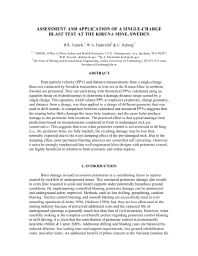Mining Publication: Assessment and Application of a Single-Charge Blast Test at the Kiruna Mine, Sweden
Original creation date: May 2011
Authors: DR Tesarik, WA Hustrulid, U Nyberg
Peak particle velocity (PPV) and distance measurements from a single-charge blast test conducted by Swedish researchers in iron ore at the Kiruna Mine in northern Sweden are presented. They are used along with theoretical PPVs calculated using an equation based on hydrodynamics to determine a damage distance range caused by a single charge. This equation, which relates PPV to explosive properties, charge geometry, and distance from a charge, was then applied to a charge of different geometry that was used in drift rounds. A comparison between calculated and measured PPVs suggests that the stoping holes likely damage the easer hole locations, and the easer holes produce damage to the perimeter hole locations. The practical effect is that typical damage limit predictions based on measurements conducted in fresh or undamaged rock are conservative. This suggests that even when perimeter control is not exercised in drifting (i.e., the perimeter holes are fully loaded), the resulting damage may be less than normally expected due to the wave damping effect of the pre-damaged rock. Due to the damping effect, poor perimeter blasting practices are somewhat self correcting. However, it must be strongly emphasized that well-engineered blast designs with perimeter control are highly beneficial in relation to both economic and safety aspects.
